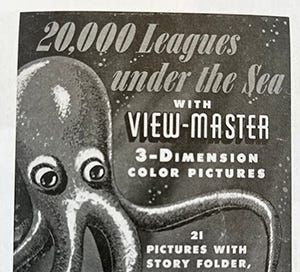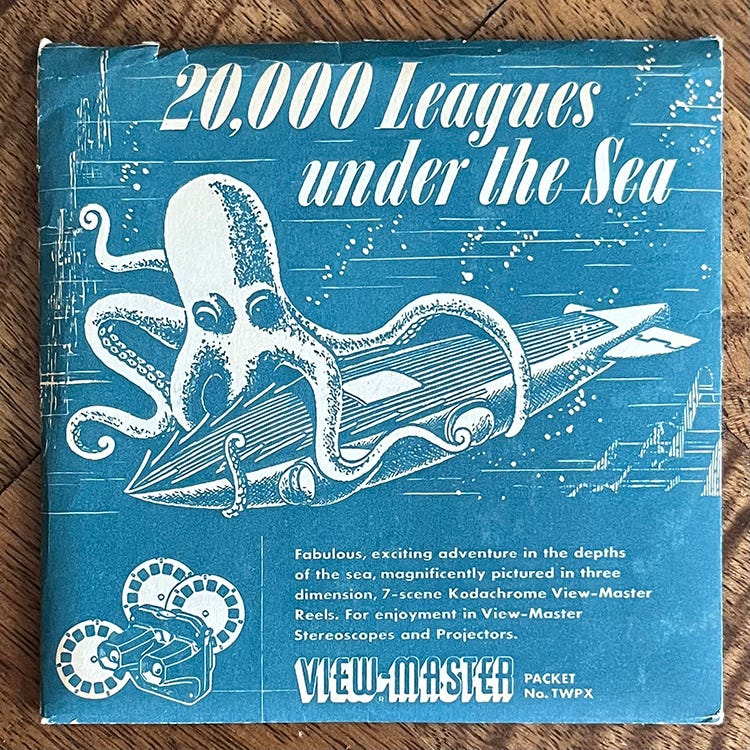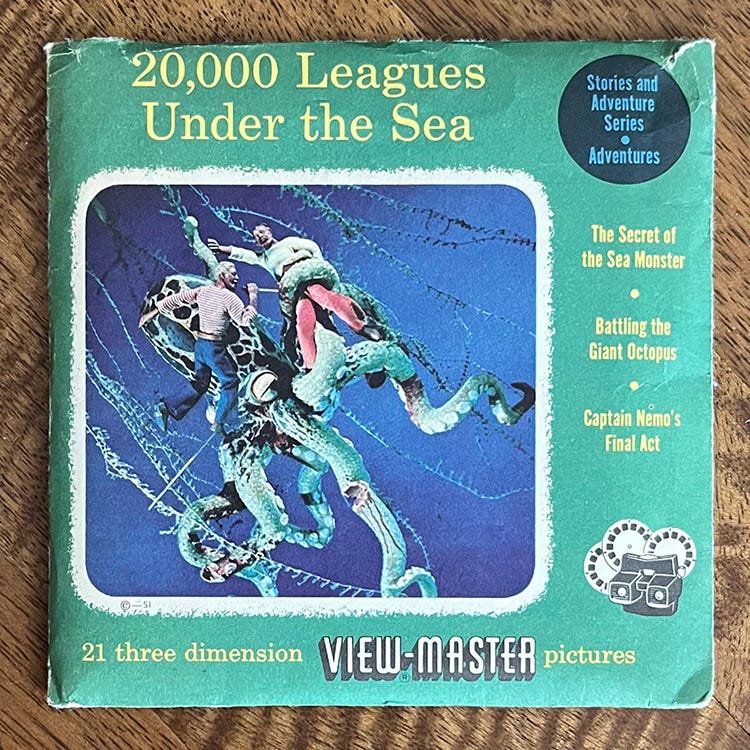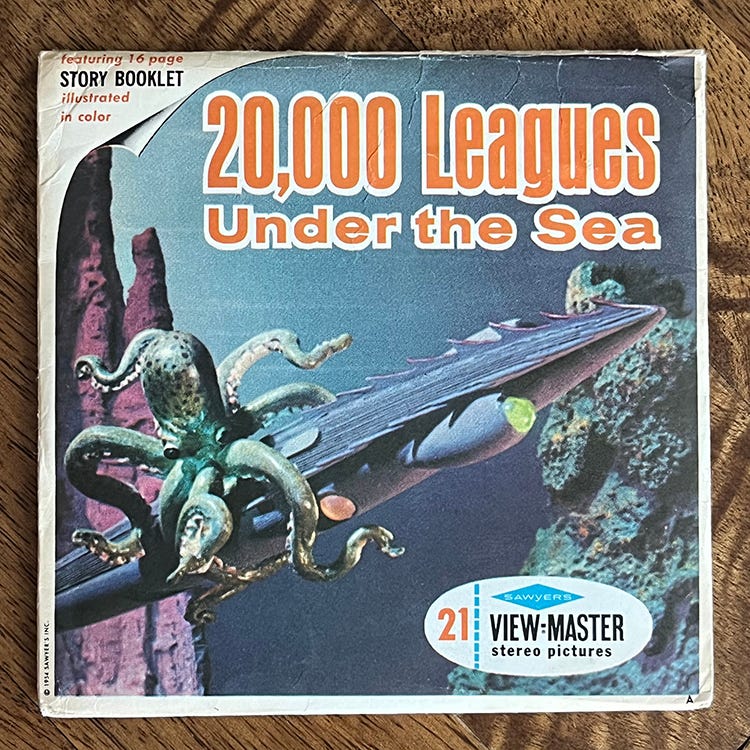View-Master enjoyed a longevity few cultural totems have achieved. From its debut in 1939 to the end of the last century, nearly every household in America (not to mention across the world) had a View-Master viewer and reels. From Baby Boomers to elder Millennials, View-Master provided a shared experience across generations.
View-Master launched in 1939 selling one-off reels that were meant to take the place of postcards. Parent company Sawyer’s was a major force in the postcard market, so they had the infrastructure to create and distribute the reels. The first packets (usually three-reel sets) were introduced just in time for Christmas in 1948. There were marketed as Stereo-Stories and were a big hit!

Some titles were reprinted and repackaged for decades. And while the contents were the same, the packaging changed with the times and provides insight into the history of the company.
Based on the Jules Verne book, 20,000 Leagues Under the Sea was introduced in the fall of 1954 — just in time for Christmas. With scenes created by Warren Chaney and Martha Armstrong, it took about four months to complete.
S1/S2 Packets
The first generation of packets, which date to the early 1950s (up to about 1955) were single color line drawings, often featuring bold typography. There are a couple of variations, known to collectors as S1 and S2 (meaning Sawyer’s style 1 and Sawyer’s style 2). I’m using 20,000 Leagues to illustrate packet styles, because I love the line drawing of the octopus so much.
S3D/S3/S4 Packets
The second iteration of packets features an image from the packets set to the left with rounded corners. The top right corner features a circle with a column of text below teasing the contents of the packet.
There are three key variations to this packet style, in order of release. The first, S3D (Sawyer’s style 3, Drawn) features a drawing or illustrating based on the images inside instead of a photo. The standard S3 (Sawyer’s style 3, pictured above) features a photo. The S4 (Sawyer’s style 4) is identical to the S3 except that it features a numerical factory code in the top right circle. Sometimes this code was simply stamped on the back of S3 packets.
For collectors, the introduction of factory numbering is important. Everyone likes an organizing principles, after all. For many years, I kept my collection in alphabetical order by place and/or title, but as my collection grew organization became unwieldy. Using Sawyer’s own numbering system has simplified things, mostly because the company had its own systematic approach to numbering, like a simplified Dewey Decimal system.
S5 Packets
Many collectors consider the S5 packet the most attractive. It’s certainly the most streamlined. This style always features one of the best photos taking up the full face of the packet with a block letter title and the View-Master logo on the bottom.
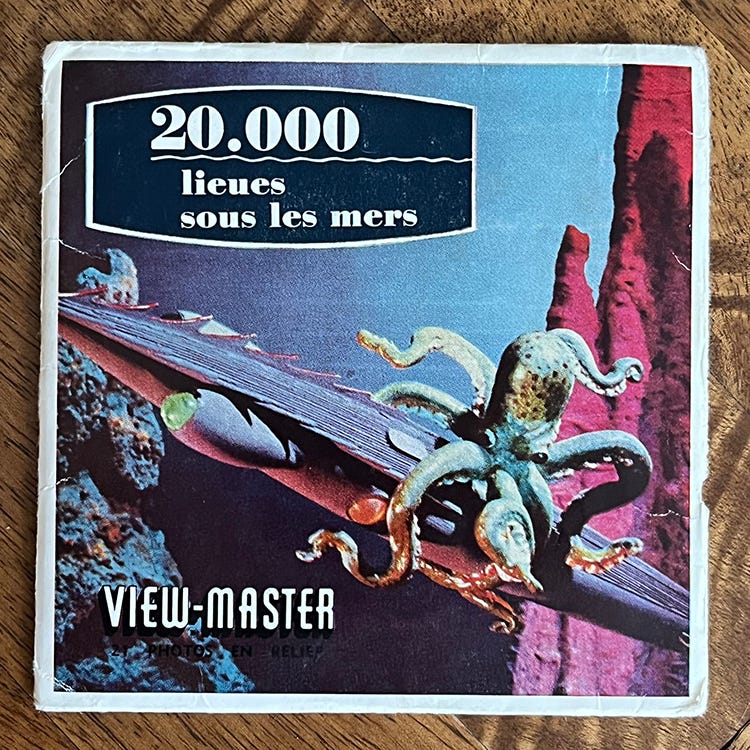
A Note about Belgian Packets
In addition to the U.S. factory in Portland, Oregon, there was a sister factor in Belgium that produced reels for the European market. They often had their own take on covers, on titles and even on booklets. Here’s a great example of the BS5 style (Belgian, Sawyer’s style 5). The aesthetics were nearly identical to U.S. packet styles so most people just put a B in front of the packets from the Belgian plant (BS2, BS3, etc.) to differentiate.
S6 Packets
The Sawyer’s 6th packet style is similar to S5, but it includes a logo update with View-Master in a white bubble on the cover. This style is usually a bit busier (note the wrap with the “STORY BOOKLET” blurb in the left top corner).
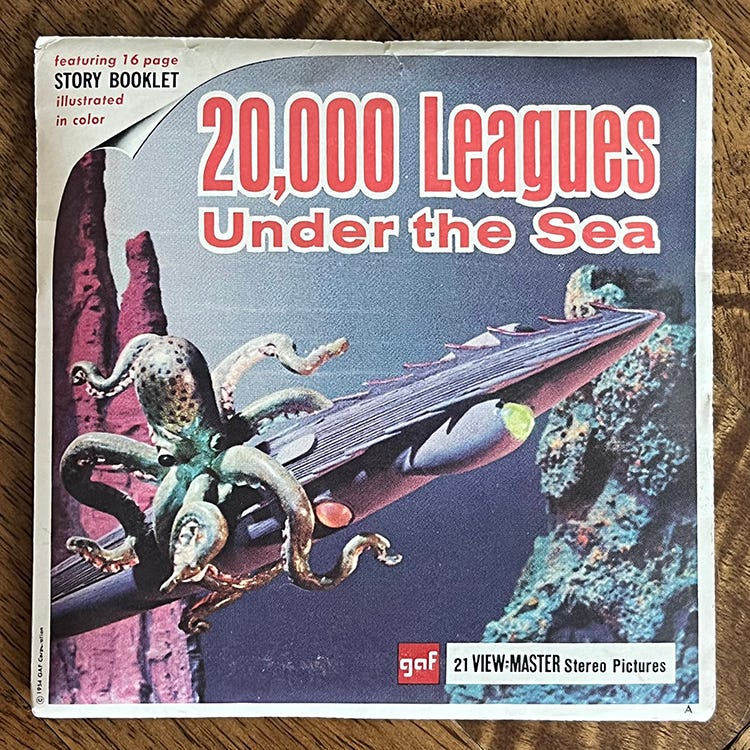
G1/G2 Packets
In 1966, GAF Corporation acquired Sawyer’s and View-Master became a subsidiary. GAF leaned heavily into kid-friendly titles and TV show tie-ins. Some collectors avoid acquiring anything from the post-Sawyer’s era. Some collectors only acquire movie and TV show reels.
The first big change from Sawyer’s to GAF was the updated logo on the front of the packets, which is what collectors call G1/G2. Now, some people get very granular about logo size and placement on the back of packets, which is where the G2 comes in, but I absolutely do not. The collecting hole is already way too deep.
G3 Packets
Introduced around 1971, the G3 packet style featured a banner across the top. There are a variety of tweaks from that point, mostly related to logo size and placement and the logo placement on the back of the packet. For example, the G4 packet is simply the gaf logo now stylized in upper case as GAF. Again, I don’t like to get that granular because they contents and even the overall packet design are identical.
In 1981, GAF sold View-Master to an investment group and they formed View-Master International. The packets of that era (known as VM1 and VM2) simply took the GAF logo off. This was the end of the road for traditional paper packets. VMI introduced the blisterpack to the U.S. market, a hanging card that would fit easily onto peg board racks at stores, and the paper packet era was over.
From everything I can tell, the 20,000 Leagues Under the Sea packet was discontinued before blisterpacks entered the U.S. market. However, blisterpacks were introduced first in Europe so there is a Belgian-made blisterpack. I snagged this off ebay as an example:

View-Master International was acquired by the Ideal Toy Company in 1984 and that company was purchased by Tyco Toys in 1989. Tyco merged with Mattel in 1997 and View-Master was placed in Mattel’s preschool division under Fisher-Price.
Today, View-Master is licensed to Basic Fun as a nostalgia toy. The viewer is garbage, and the reels seem to be recycled from 1990s-era packets.
Side note: I know many of you are far more interested in the contents than the packaging. For an incredible behind-the-scenes look at how the product was produced, check out this video from a 1954 TV show, uploaded by View-Master collector and historian Wolfgang Sell.
For the kind folks who decided to pay me for this newsletter, I’ve added a section about the various booklet styles that came with the 20,000 Leagues Under the Sea Packet below. Thanks for your support, friends!
